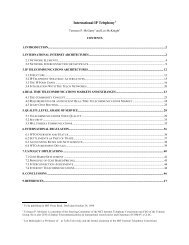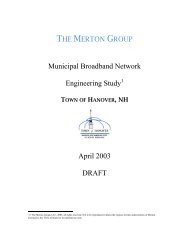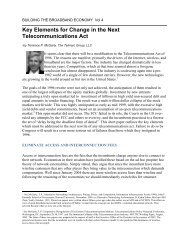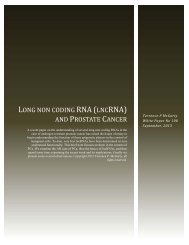progressivism, individualism, and the public ... - Telmarc Group
progressivism, individualism, and the public ... - Telmarc Group
progressivism, individualism, and the public ... - Telmarc Group
Create successful ePaper yourself
Turn your PDF publications into a flip-book with our unique Google optimized e-Paper software.
The <strong>Telmarc</strong> <strong>Group</strong><br />
PROGRESSIVISM, INDIVIDUALISM, AND THE PUBLIC<br />
INTELLECTUAL<br />
by <strong>the</strong> world view. The architecture may be <strong>the</strong> written, spoken, or even unspoken set of<br />
rules as to what <strong>the</strong> government is doing. In a sense <strong>the</strong> basic architecture that we started<br />
with was <strong>the</strong> Constitution, <strong>and</strong> as time has gone by, as Sunstein, <strong>and</strong> many of <strong>the</strong> o<strong>the</strong>rs<br />
we have dealt with as <strong>the</strong> Progressives <strong>and</strong> neo-progressives, <strong>the</strong>y see it as a malleable<br />
plan which can <strong>and</strong> should be changed to meet <strong>the</strong> changing world view.<br />
The world view is <strong>the</strong> core framework of <strong>the</strong> mindset that those who govern bring with<br />
<strong>the</strong>m to <strong>the</strong> table <strong>and</strong> what <strong>the</strong>y use along with <strong>the</strong> o<strong>the</strong>r tools available to craft <strong>and</strong><br />
restructure <strong>the</strong> architecture. Thus Reagan was somewhat of a neoliberal in a Lockean<br />
sense, with a bit of <strong>the</strong> laissez faire attitude towards markets <strong>and</strong> Government regulation.<br />
Obama is a strong neo-progressive, seeing <strong>the</strong> world in just <strong>the</strong> opposite direction, <strong>and</strong><br />
thus interpreting <strong>the</strong> Constitution in a manner requiring strong Governmental<br />
intervention. Like TR <strong>and</strong> even to some degree Wilson, Obama seems to view <strong>the</strong><br />
capitalist elements in an "us versus <strong>the</strong>m" world, as cause of everything from <strong>the</strong><br />
financial collapse, global warming, loss of jobs <strong>and</strong> <strong>the</strong> list would go on. TR had similar<br />
views on Trusts <strong>and</strong> <strong>the</strong>ir power a century ago.<br />
What we see often is not <strong>the</strong> "world view" of <strong>the</strong> governing class, we see only <strong>the</strong>ir<br />
interpretation of <strong>the</strong> architecture via <strong>the</strong> acts <strong>the</strong> execute. The world view we will argue is<br />
critical to underst<strong>and</strong> <strong>and</strong> all too often <strong>the</strong> world view is seen through <strong>the</strong> architecture<br />
implemented. Thus <strong>the</strong>re is a deconstructing of a world view through <strong>the</strong> structures <strong>and</strong><br />
actions taken.<br />
The concept of an architecture has been a cornerstone in <strong>the</strong> development of new system,<br />
whe<strong>the</strong>r it be a technological system, political system, business system or social system.<br />
For example <strong>the</strong> US Constitution is in essence <strong>the</strong> architecture for <strong>the</strong> United States <strong>and</strong><br />
its operations. However, <strong>the</strong> structural elements which make up <strong>the</strong>se architectures have<br />
often not played a role in <strong>the</strong> development of policies. We will develop <strong>the</strong> concept of an<br />
architecture as a means to underst<strong>and</strong> <strong>the</strong> network as both a market <strong>and</strong> regulatory entity,<br />
<strong>and</strong> will provide a new set of perspectives for viewing <strong>the</strong> network in terms of a new<br />
paradigms <strong>and</strong> world views.<br />
The architecture is composed of <strong>the</strong> elements <strong>and</strong> <strong>the</strong> elements are reflected in <strong>the</strong><br />
effectors which perform <strong>the</strong> functions of <strong>the</strong> elements. In a building <strong>the</strong> element may be a<br />
beam <strong>and</strong> <strong>the</strong> effector may be a steel reinforced concrete beam. In a political system <strong>the</strong><br />
legislator may be an element <strong>and</strong> <strong>the</strong> effectors are <strong>the</strong> senators <strong>and</strong> representatives, <strong>the</strong><br />
actual people performing <strong>the</strong> function.<br />
An architecture, thus, first, requires that <strong>the</strong> underlying system be treated in terms of a set<br />
of commonly understood elements <strong>and</strong> that <strong>the</strong>se elements have a clearly demarcated set<br />
of functions <strong>and</strong> interfaces that allow for <strong>the</strong> combining of <strong>the</strong> basic set of elements. The<br />
way <strong>the</strong> elements <strong>the</strong>n can be combined, reflected against <strong>the</strong> ultimate types of services<br />
provided, determine <strong>the</strong> architecture. Thus for a government we may think of <strong>the</strong><br />
elements as <strong>the</strong> executive, legislative <strong>and</strong> judicial, but that is but one of many<br />
alternatives.<br />
Page 189












